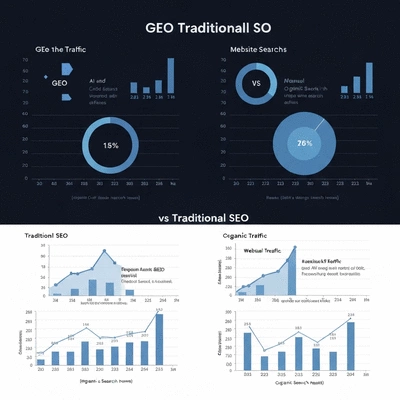As digital landscapes evolve, the ability to adapt is critical. The rise of Generative Engine Optimization (GEO) signals a paradigm shift in how search engines evaluate content. Are you prepared to embrace this transformation and enhance your online visibility?
What You Will Learn
- GEO focuses on AI-driven content creation, enhancing visibility in generative AI-powered search engines.
- It emphasizes understanding and responding to user intent, improving content relevance and engagement.
- GEO allows for real-time adjustments to SEO strategies based on user data and behavior.
- Integrating GEO with traditional SEO tactics creates a holistic approach to digital marketing.
GEO vs. Traditional SEO: Key Distinctions and Synergies
This visual highlights the main differences and complementary aspects of Generative Engine Optimization (GEO) and Traditional SEO, emphasizing their roles in modern digital marketing.
Understanding Generative Engine Optimization (GEO) in Today’s Digital Landscape
As someone deeply immersed in the world of digital marketing, I've seen transformations that can reshape how we approach search. One such transformation is the rise of Generative Engine Optimization (GEO). But what exactly does GEO mean, and why is it becoming a cornerstone of modern SEO practices? Let’s unveil its definition and purpose.
Defining Generative Engine Optimization and Its Purpose
Generative Engine Optimization (GEO) refers to the techniques and strategies tailored to enhance visibility in search engines that utilize generative AI. This includes optimizing content and structures to meet the unique demands of AI algorithms. At its core, GEO aims to improve how content is understood and indexed by these intelligent systems, ultimately leading to better rankings and user engagement. Research, such as the paper on "Generative AI-Powered Search Engines: The Opportunities and Challenges", highlights the significant role generative AI plays in reshaping search engine functionalities.
- Focus on AI-driven content creation
- Adaptation to evolving user expectations
- Enhancement of content relevance and context
By aligning with AI methodologies, GEO not only addresses current search requirements but also anticipates future trends. This proactive approach is essential for maintaining a competitive edge in an increasingly digital marketplace.

The Importance of GEO in Modern SEO Strategies
In today's SEO landscape, GEO is not just an option; it's a necessity. As search engines evolve, they increasingly prioritize content that is contextually relevant and user-friendly. By integrating GEO into your SEO strategy, you can ensure that your content resonates with both AI algorithms and your audience. The shift towards AI-powered search is clearly articulated in studies like "Generative AI for Search: A Paradigm Shift", which emphasizes the critical role of generative AI in current and future search technologies.
- Enhances visibility in AI-powered search engines
- Improves content discoverability and relevance
- Drives higher engagement rates and conversions
Investing in GEO practices can yield significant returns, making it an integral component of any comprehensive digital marketing strategy. The synergy between GEO and traditional SEO enhances overall effectiveness, allowing businesses to thrive in a competitive online environment.
How Generative AI Influences GEO and Search Engines
Generative AI is revolutionizing the way search engines process and deliver content. By leveraging machine learning and natural language processing, these technologies can understand user intent much more deeply than before. This results in more accurate and relevant search results, which is where GEO comes into play. Insights from academic papers, such as "The Impact of Generative AI on Search Engine Optimization", further elaborate on how generative AI is transforming SEO practices.
- Generative AI tailors content suggestions based on user behavior
- It enhances semantic understanding of search queries
- AI-driven insights inform content creation strategies
As we adapt our strategies to incorporate these AI capabilities, the goal is to create content that not only meets the technical requirements but also genuinely serves the needs of users. By doing so, we position ourselves to harness the full power of Generative Engine Optimization.
Comparing GEO and Traditional SEO: What You Need to Know
Understanding the distinctions between GEO and traditional SEO is crucial for effectively adapting to the evolving digital landscape. Each approach has its unique strengths, and recognizing these can help shape your strategies for maximum impact.
Interactive Poll: Your Thoughts on GEO
As we delve deeper into the world of Generative Engine Optimization, we want to hear from you! How do you feel about the integration of AI in SEO strategies? Share your perspective:
Comparing GEO and Traditional SEO: What You Need to Know
Understanding the distinctions between Generative Engine Optimization (GEO) and traditional SEO is crucial for adapting your digital marketing strategies. As a passionate advocate for keeping up with evolving trends at Get Better Rankings, I believe that recognizing these differences can significantly enhance your website's performance. Let’s uncover the key contrasts that shape our approach to optimization today!
Key Differences Between GEO and Traditional SEO Approaches
When we talk about GEO versus traditional SEO, we’re diving into a landscape where technology and user behavior are rapidly changing. Here are the main differences:
- Data Utilization: GEO leverages vast amounts of data, often driven by AI, to generate optimized content based on real-time user interactions.
- Search Algorithms: GEO focuses on understanding and responding to complex search queries, while traditional SEO often concentrates on keyword density and backlinks.
- User Intent: GEO prioritizes user intent and context, enhancing relevancy in search results compared to the more straightforward keyword-based approach of traditional SEO.
By recognizing these differences, we can better tailor our strategies to match the current landscape of digital marketing. Adapting to these shifts is no longer optional—it's essential for staying competitive!

How GEO Complements and Enhances Conventional SEO Tactics
While GEO and traditional SEO may have their differences, they are not mutually exclusive. In fact, GEO can enhance existing SEO practices in several ways:
- Dynamic Content Creation: GEO can automatically generate relevant content that appeals to user queries while enriching the existing content framework.
- Real-Time Adjustments: With the ability to analyze user data instantly, GEO allows for quicker adjustments to SEO strategies based on current trends.
- Holistic Optimization: By integrating GEO techniques, businesses can apply a more comprehensive approach to user engagement and satisfaction.
Incorporating GEO into your traditional SEO efforts can be a game-changer. It creates a synergistic effect that propels your website to new heights!
The Role of Search Intent and Semantic Search in GEO
Search intent has become a cornerstone of both GEO and traditional SEO strategies. Understanding what users are genuinely looking for is vital in delivering relevant content.
- Types of Search Intent:
- Informational: Users seeking knowledge.
- Navigational: Users looking for specific websites.
- Transactional: Users ready to make a purchase.
- Semantic Search: This feature helps search engines understand the context of queries, making it easier for GEO to generate accurate and relevant content.
- Enhancing User Experience: By focusing on search intent, GEO can significantly enhance the user experience, leading to higher engagement rates.
By prioritizing search intent, we're not just optimizing for algorithms; we’re creating better experiences for our users, which ultimately leads to improved conversion rates!
Implementing Effective GEO Strategies for Enhanced Visibility
Now that we've established the significance of GEO in comparison to traditional SEO, let's move on to implementing effective strategies that boost your website's visibility. At Get Better Rankings, we’re here to equip you with practical insights that drive results!
Frequently Asked Questions (FAQs) about Generative Engine Optimization (GEO)
- What is Generative Engine Optimization (GEO)?
- GEO refers to techniques and strategies designed to improve content visibility in search engines that use generative AI. It focuses on optimizing content and structures to meet the demands of AI algorithms for better rankings and user engagement.
- How does GEO differ from traditional SEO?
- GEO primarily leverages AI-driven data for content generation, focuses on complex search queries, and prioritizes real-time user interactions and context. Traditional SEO, on the other hand, often concentrates on keyword density, backlinks, and a more straightforward keyword-based approach.
- Why is GEO important in modern SEO strategies?
- GEO is essential because search engines increasingly prioritize contextually relevant and user-friendly content. Integrating GEO enhances visibility in AI-powered search engines, improves content discoverability, and drives higher engagement rates and conversions.
- How does Generative AI influence GEO?
- Generative AI revolutionizes how search engines process content by understanding user intent more deeply. It tailors content suggestions based on user behavior, enhances the semantic understanding of search queries, and informs content creation strategies, all of which are central to GEO.
- What role does search intent play in GEO?
- Search intent is a cornerstone of GEO. Understanding whether users are seeking information (informational), looking for specific websites (navigational), or ready to make a purchase (transactional) allows GEO to deliver highly relevant content, improving user experience and conversion rates.
Recap of Key Points
Here is a quick recap of the important points discussed in the article:
- Generative Engine Optimization (GEO) enhances visibility in AI-powered search engines by focusing on user intent and context.
- GEO complements traditional SEO by enabling dynamic content creation and real-time adjustments based on user data.
- Understanding search intent and semantic search is crucial for delivering relevant content and improving user experience.
- Implementing GEO strategies can significantly boost engagement rates and conversion opportunities in a competitive digital landscape.






